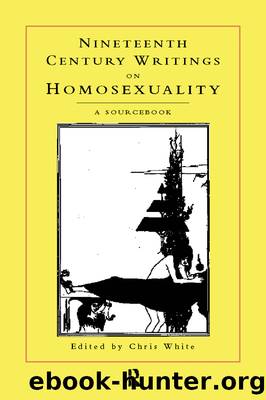Nineteenth-Century Writings on Homosexuality by White Chris

Author:White, Chris
Language: eng
Format: epub
Publisher: Taylor & Francis (CAM)
XIX
Sexual inversion among Greek women offers more difficulties than we met with in the study of paiderastia. This is due, not to the absence of the phenomenon, but to the fact that feminine homosexual passions were never worked into the social system, never became educational and military agents. The Greeks accepted the fact that certain females are congenitally indifferent to the male sex, and appetitive of their own sex. This appears from the myth of Aristophanes in Plato’s Symposium, which expresses in comic form their theory of sexual differentiation. There were originally human beings of three sexes: men, the offspring of the sun; women, the offspring of the earth; hermaphrodites, the offspring of the moon. They were round with two faces, four hands, four feet, and two sets of reproductive organs apiece. In the case of the third (hermaphroditic or lunar) sex, one set of reproductive organs was male, the other female. Zeus, on account of the insolence and vigour of these primitive human creatures, sliced them into halves. Since that time the halves of each sort have always striven to unite with their corresponding halves, and have found some satisfaction in carnal congress—males with males, females with females, and (in the case of the lunar or hermaphroditic creatures) males and females with one another. Philosophically, then, the homosexual passion of female for female, and of male for male, was placed upon exactly the same footing as the heterosexual passion of each sex for its opposite. Greek logic admitted the homosexual female to equal rights with the homosexual male, and both to the same natural freedom as heterosexual individuals of either species.
Although this was the position assumed by philosophers, Lesbian passion, as the Greeks called it, never obtained the same social sanction as boy-love. It is significant that Greek mythology offers no legends of the goddesses parallel to those which consecrated paiderastia among the male deities. Again, we have no recorded example, so far as I can remember, of noble friendship between women rising into political and historical prominence. There are no female analogies to Harmodius and Aristogeiton, Cratinus and Aristodemus. It is true that Sappho and the Lesbian poetess gave this female passion an eminent place in Greek literature. But the Æolian women did not find a glorious tradition corresponding to that of the Dorian men. If homosexual love between females assumed the form of an institution at one moment in Æolia, this failed to strike roots deep into the subsoil of the nation. Later Greeks, while tolerating, regarded it rather as an eccentricity of nature, or a vice, than as an honourable and socially useful emotion. The condition of women in ancient Hellas sufficiently accounts for the result. There was no opportunity in the harem or the zenana of raising homosexual passion to the same moral and spiritual efficiency as it obtained in the camp, the palaestra, and the schools of the philosophers. Consequently, while the Greeks utilised and ennobled boy-love, they left Lesbian love to follow the same course of degeneracy as it pursues in modern times.
Download
This site does not store any files on its server. We only index and link to content provided by other sites. Please contact the content providers to delete copyright contents if any and email us, we'll remove relevant links or contents immediately.
| Ancient & Classical | Arthurian Romance |
| Beat Generation | Feminist |
| Gothic & Romantic | LGBT |
| Medieval | Modern |
| Modernism | Postmodernism |
| Renaissance | Shakespeare |
| Surrealism | Victorian |
4 3 2 1: A Novel by Paul Auster(11087)
The handmaid's tale by Margaret Atwood(6887)
Giovanni's Room by James Baldwin(5910)
Big Magic: Creative Living Beyond Fear by Elizabeth Gilbert(4743)
Asking the Right Questions: A Guide to Critical Thinking by M. Neil Browne & Stuart M. Keeley(4612)
On Writing A Memoir of the Craft by Stephen King(4233)
Ego Is the Enemy by Ryan Holiday(4013)
Ken Follett - World without end by Ken Follett(3985)
The Body: A Guide for Occupants by Bill Bryson(3843)
Bluets by Maggie Nelson(3736)
Adulting by Kelly Williams Brown(3690)
Guilty Pleasures by Laurell K Hamilton(3607)
Eat That Frog! by Brian Tracy(3537)
White Noise - A Novel by Don DeLillo(3447)
The Poetry of Pablo Neruda by Pablo Neruda(3380)
Alive: The Story of the Andes Survivors by Piers Paul Read(3327)
The Book of Joy by Dalai Lama(3245)
The Bookshop by Penelope Fitzgerald(3242)
Fingerprints of the Gods by Graham Hancock(3233)
